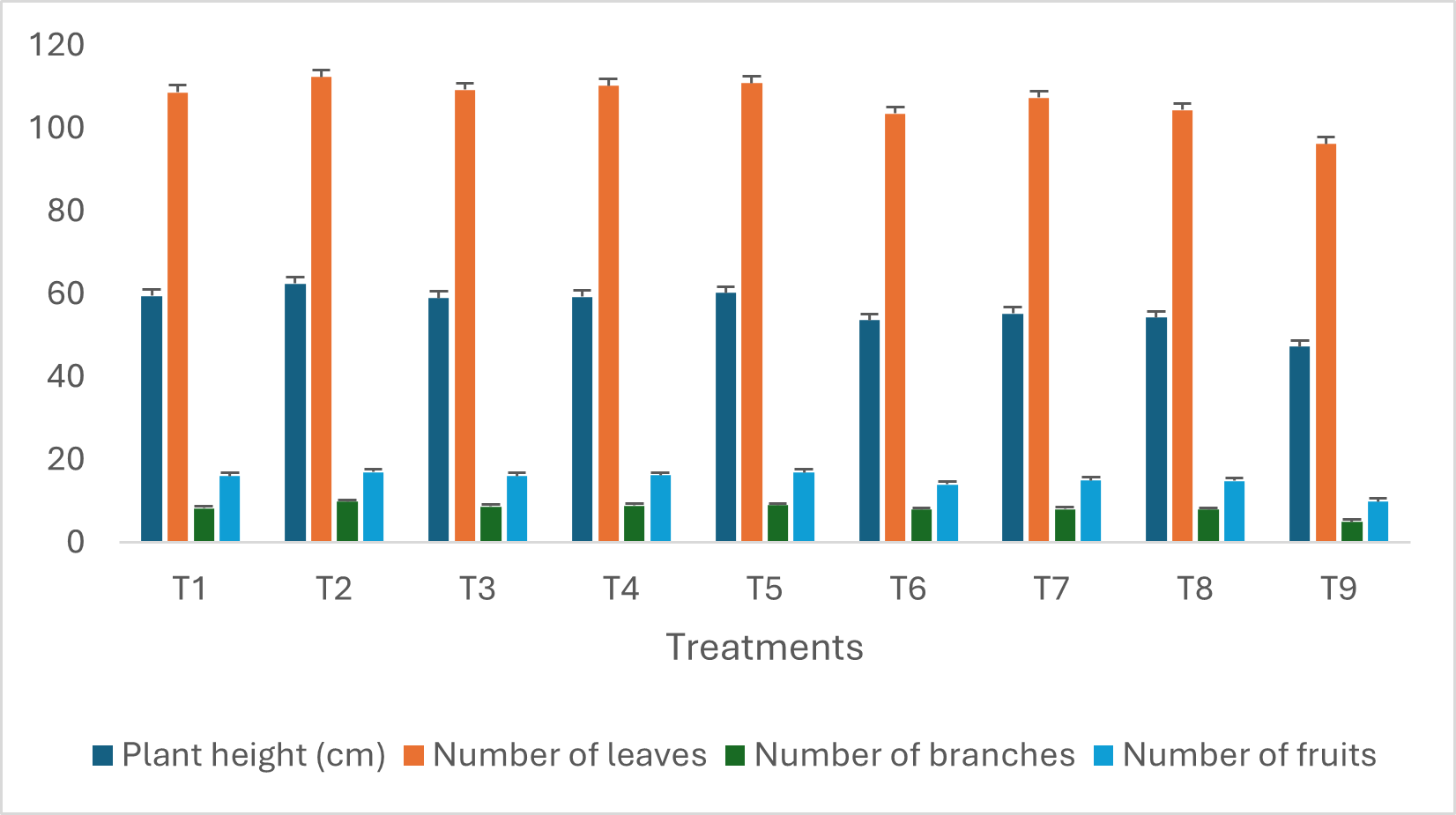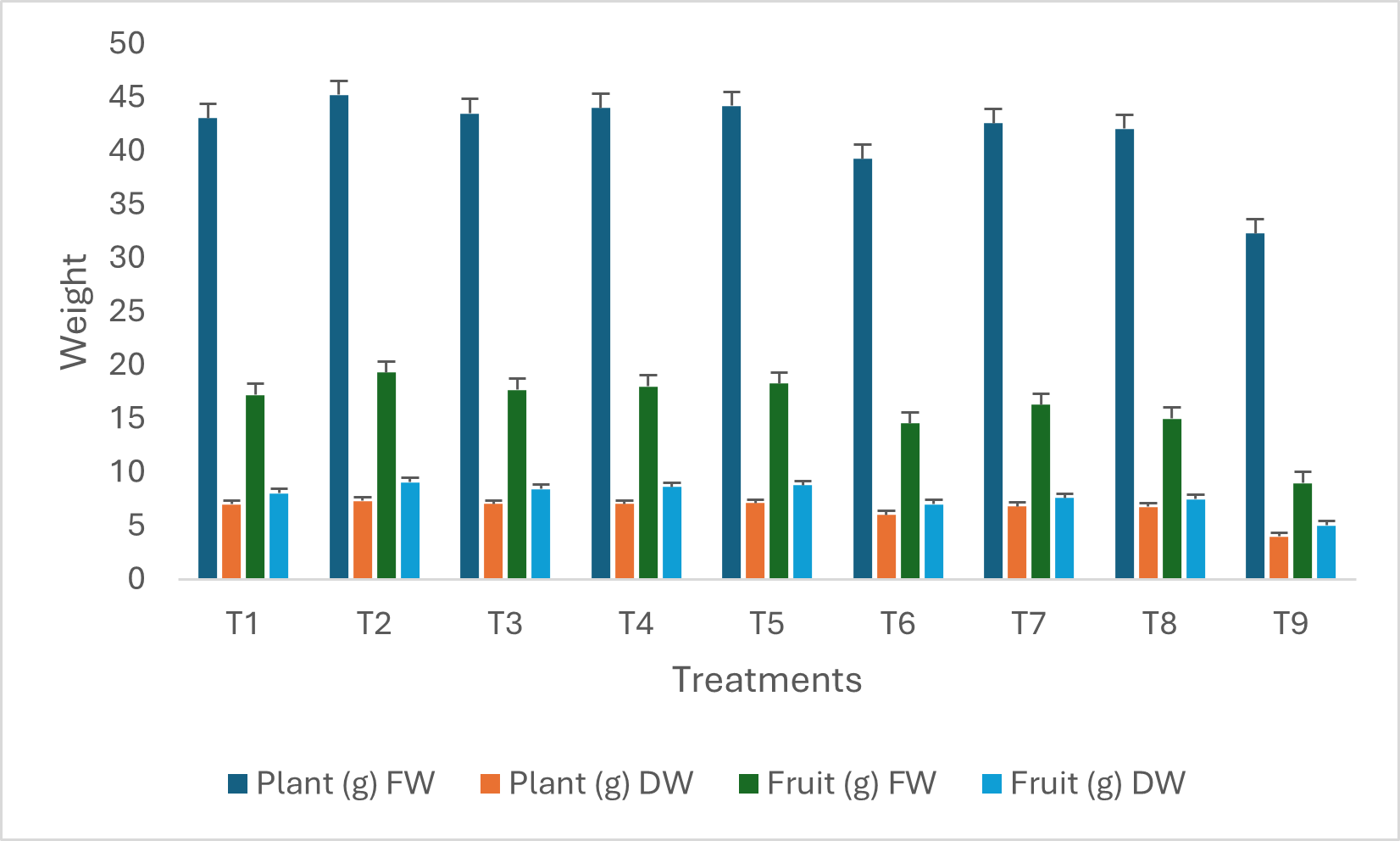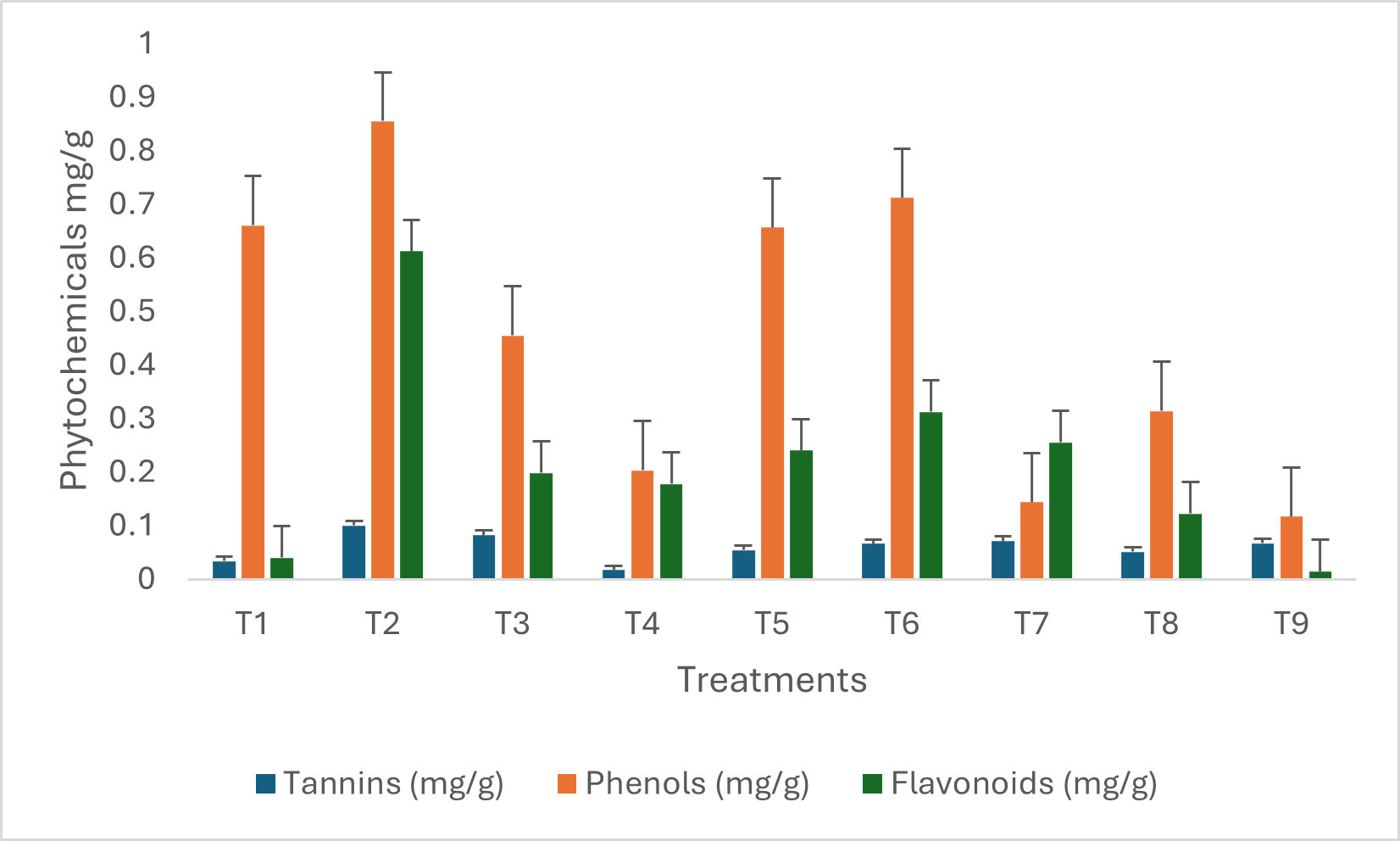Hemant Bagul1*, Nikita Patel1, Alpesh Rathwa2, Nitesh Jadav3, and Ramar Krishnamurthy1
1Kishorbhai Institute of Agriculture Sciences and Research Centre, Uka Tarsadia University,
Bardoli, Gujarat, India
2College of Horticulture, Jagudan, Sardarkrishinagar Dantiwada Agricultural University.
Dist. Mehsana
3College of Agriculture, Waghai, Navsari Agricultural University, Navsari
*Corresponding Author: Hemant Bagul, Kishorbhai Institute of Agriculture Sciences and Research Centre, Uka Tarsadia University, Bardoli, Gujarat, India.
Received: July 17, 2024; Published: August 04, 2024
Citation: Hemant Bagul., et al. “Impact of Foliar Application of liquid bioenhancers on Growth and Phytoconstituents of Chilli (Capsicum annum L.)". Acta Scientific Paediatrics 8.9 (2024):03-08.
An experiment was conducted at farmer field in 2023-24 to study the impact of foliar application of liquid bioenhancers on Chilli (Capsicum annum L.). The experiment was laid out in a Completely Randomized Design comprising of nine treatments namely viz., T1- Novel liquid nutrient fertilizer 1 %, T2- Novel liquid nutrient fertilizer 3 %, T3- Panchagavya 2 %, T4- Panchagavya 3 %, T5- Vermiwash 5 %, T6-Amritpani 2 %, T7- Bijamrut 2 %, T8-Jeevamruth 1 % and T9- control (water spray). Chilli plants were sprayed at 45 days after sowing and each treatment was repeated thrice and all parameters were taken 90 days after transplanting. Experimental results indicated that the foliar application of Novel liquid nutrient fertilizer 3 % recorded the maximum growth attributes viz., plant height, number of leaves, number of branches, fresh weight and dry weight of plant, fresh weight and dry weight of fruit, number of fruits per plant. Whereas, phytoconstituents viz., Chlorophyll a and b, carotenoid, phenols, tannin, flavonoids and ascorbic acid were recorded significantly maximum with Novel liquid nutrient fertilizer 1 %.
Keywords: Chilli; Organic Sprays; Novel Liquid Nutrient Fertilizer; Growth and Yield Attributes; Phytoconstituents
Capsicum annum L., or chilli pepper, is a crop of considerable economic importance. It includes calcium, vitamin A, B1, and C as well as protein, lipids, and carbohydrates. Additionally, chilli include bioflavonoids and other phytoconstituents [1]. Consumption of chilli is rising about 14% per year. The anticipated annual demand for chilli is between 720.000 and 840.000 tonnes. As a result, it is important to produce chillies in order to provide and satisfy community and industrial demand. As a significant crop, chillies are utilised as both spices and green vegetables. The alkaloid capsaicin is responsible for the pungency of chillies. States like Andhra Pradesh, Karnataka, Maharashtra, West Bengal, Rajasthan, etc. are the important chilli farming states in India [2]. There is a higher danger of health risks with the negligent use of fertilizers and chemicals. Vegetables are typically consumed in raw or partially cooked form and hence they must be free from harmful chemical fertilizers and pesticides. Additionally, the health of the soil has been diminished as a result of ongoing usage of chemical fertilizers. To cope up with this integrated nutrient management using organic fertilizers has gained much importance [3].
One of the widest spectrum of environmentally friendly approaches to farming is organic agriculture. Inorganic fertilizer application to agriculture is now standard procedure, and the use of compost made from different types of green waste in agriculture is slowly making a comeback [4]. Foliar spray of organic nutrient cause tremendous impact on growth and yield of crop and incorporation of organic nutrient in crop cultivation increases the growth and yield of plant without adversely impact on soil and environment.
Due to their high cost and sporadic unavailability in the market, inorganic fertilizers are frequently not applied to agricultural fields at the most effective periods by farmers. However, compared to artificial fertilizers, organic manure is more freely accessible to farmers and costs less. Most frequently, this novel technology is often referred to as a technique for safeguarding the soil’s natural fertility, diversity and ecological balance of the environment. The majority of small-scale farmers continue to rely mostly on unimproved crop types, soil and human labour. Crop yields are said to have increased by almost 50% as a result of fertilizer application [5]. It is commonly acknowledged that organic farming, which is based on nature, is environmentally benign, and assures resource conservation for the future, might function as a comprehensive strategy for attaining sustainable agriculture. These chilies might be lucrative speciality crops for small- and medium-sized farmers. Hence the present study deals with evaluation of biochemical parameters, growth attributes of chilies under varied foliar application of bioenhancers.
The present experiment was conducted during the year 2023-24 at farmer field, The Dangs, Gujarat, India. The experiment was laid out with nine treatments comprising of T1- Novel liquid nutrient fertilizer 1 %, T2- Novel liquid nutrient fertilizer 3 %, T3- Panchagavya 2 %, T4- Panchagavya 3 %, T5- Vermiwash 5 %, T6-Amritpani 2 %, T7- Bijamrut 2 %, T8-Jeevamruth 1 % and T9- control (water spray) which were repeated thrice. Chilli plants were sprayed at 45 days after sowing.
The estimation of chlorophyll a & b was carried out according to the method given by Arnon [6]. The chlorophyll content in the leaves was estimated by weighing 1.0 gm of fresh leaves and was grounded with pestle and mortar. Then, 10 ml of 80% acetone was added to it and was kept overnight. Next to that those samples were homogenized at 3000 rpm for 15 minutes. The absorbance of the samples were recorded at 645 nm and 663 nm respectively.
Chlorophyll mg/g fresh weight was calculated by the formula given below:
Chl a (mg/g) = [{(12.7 x ABS663) – (2.69 x ABS645)} x V]/ 1000 x W
Chl b (mg/g) = [{(22.9 x ABS645) – (4.68 x ABS663)} x V]/1000 x W
Where;
ABS663 = Absorbance at 663 nm
ABS645 = Absorbance at 645 nm
V = Volume of acetone
W = Weight of sample
The total flavonoid content from chilli was estimated by Aluminium chloride colorimetric method. The extracts were prepared using methanol as a solvent. 500µl of chilli extract was collected in a test tube. To each test tube 1500 µl methanol, 100 µl aluminium chloride solution, 100 µl potassium acetate solution and 2800 µl distilled water was added and mixed well. Absorbance was read at 415 nm and quercetin was used for standard calibration curve [7].
The amount of total phenolics in chilli extracts was determined by using Folin- Ciocalteu reagent. Gallic acid was used as a standard and the total phenolics were expressed as mg/g gallic acid equivalents (GAE). 500 µl of sample was introduced into test tubes and mixed with 2500 µl of a 10 fold diluted Folin- Ciocalteu reagent and 2000 µl of 7.5% sodium carbonate. The tubes were allowed to stand for 30 minutes at room temperature and the absorbance was at read at 760 nm spectrophotometrically [8].
The amount of total tannins in chilli extracts was determined by using Folin- Ciocalteu reagent. Tannic acid was used as a standard and the total tannins were expressed as mg/g tannic acid equivalents (TAE). 500 µl of sample was introduced into test tubes and mixed with 500 µl of a 10 fold diluted Folin- Ciocalteu reagent and 2500 µl of 2.5% sodium carbonate. The tubes were allowed to stand for 15 minutes at room temperature and the absorbance was at read at 700 nm spectrophotometrically [9].
The samples were homogenized, in 0.5% oxalic acid were ground under 4 % trichloroacetic acid. Samples were filtered. To that 4-ml aliquots of each extract and of a dehydroascorbic acid standard solution were placed in tubes and 1 ml of 2,4-dinitro-phenylhydrazine reagent’ was added to each tube. Three groups of tubes, each containing the extracts and dehydroascorbic acid standard solution mixed with reagent, were treated as follows. They were incubated in a water bath at 37℃ for 3 hours. After Incubation, 5 ml of 85% H2S04 was added dropwise to each tube in an ice bath. The Absorbance was measured at 520nm where Ascorbic acid was used for standard calibration curve [10].
The mean data concerned with the effect of different bioenhancers on growth parameters are presented in (Figure 1).

Figure 1: Growth Parameters of Chilli under foliar application of treatments
Plants under the treatment T2 showed significant effect in aspects of plant height and noted the maximum results at i.e., (62.50 cm), respectively. Same treatment T2 recorded the highest number of leaves per plant (112.35), number of branches per plant (9.89) and number of fruits per plant (17.00).
In terms of fresh (45.23 g) and dry weight (7.29 g) of plant and fresh (19.29 g) and dry weight (9.05 g) of fruit after final picking significantly maximum noted under the same treatment (Figure 2).

Figure 1: Fresh (FW) and Dry weight (DW) of Whole Plant and Fruits of Chilli under foliar application of treatments.
Gibberellic acid, naphthalene acetic acid, and cytokinin, growth regulators found in Novel liquid nutrient fertilizer, may have stimulated meristemal activities, leading to enhanced cell division and elongation, which may account for the increase in plant height and branch count [11]. The high concentration of nitrogen in liquid nutrients may also be a contributing factor. This is because increased nitrogen promotes cell division, elongation, and tissue development, all of which contribute to luxuriant vegetative growth and taller plants [12]. In green gram, cowpea, and okra, Patel., et al. [13] have also found findings that are comparable. The luxuriant and broad improvement of the vegetative growth may have been the cause of the observed rise in the fresh and dry weight of the plant.
The observed increase in fresh and dry weight of plant might have been due to the luxurious and overall promotion in the vegetative growth. Another feasible reason behind these results might be the greater accumulation of photosynthates by vegetative parts as well as the efficient partitioning of photosynthates towards the sink. The results are in conformity with the findings of Patel., et al., [13] in green gram, Singhal., et al., [14] in cow pea and Salunkhe., et al., [15] and Sahu., et al., [16] in onion.
The phytoconstituents such as phenolics (0.855 mg/g), flavonoids (0.612 mg/g) and tannins (0.10 mg/g) were reported to be highest in treatment T2 followed by other treatments which is depicted in (Figure 3). The chlorophyll a (3.12 mg/g), chlorophyll b (1.14 mg/g) and total chlorophyll content (4.26 mg/g) was also recorded highest in treatment T1 followed by other treatments which depicts the healthy nature of the plant (Figure 4). The higher value of ascorbic acid content (44 mg/100g) observed in same treatment (Figure 5).

Figure 3: Phytochemical profile of chilli under foliar application of treatments.

Figure 4: Phytochemical profile of chilli under foliar application of treatments.

Figure 5: Ascorbic Acid content of chilli under foliar application of treatments.
The results showed increase in chlorophyll content and other phytoconstituents in leaves with foliar application of Novel liquid nutrient fertilizer in the study might be related with the supply of essential nutrients to the plants. Subsequently chlorophyll synthesis in the plants is directly associated to the obtainability of the physiologically active Fe, N, P and S nutrients. The foliar application of Novel liquid nutrient fertilizer encompass N, P, K, S and micronutrients in plant available form. Therefore, availability of these nutrients to plants aid in the development of chlorophyll in the leaves. Improved total chlorophyll in green leaves with foliar application of Novel liquid nutrient fertilizer has also been reported by Tejada and Gonzalez [17].
The augmentation of ascorbic acid content might due to either increased ascorbic acid biosynthesis or to protection of synthesized ascorbic acid from oxidation through ascorbic acid oxidase [18].
Based on the investigation, it can be concluded that spraying Novel liquid nutrient fertilizer 3 %, at 45 days after sowing were most effective for improving fruit weight and yield attributes in chilli. Whereas phytoconstituents attributes were improved without affecting quality of chili.
Copyright: © 2024 Hemant Bagul., et al. This is an open-access article distributed under the terms of the Creative Commons Attribution License, which permits unrestricted use, distribution, and reproduction in any medium, provided the original author and source are credited.
ff
© 2024 Acta Scientific, All rights reserved.